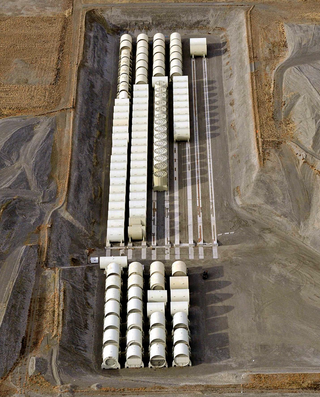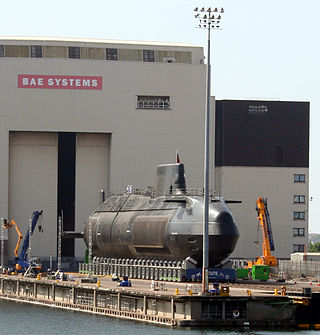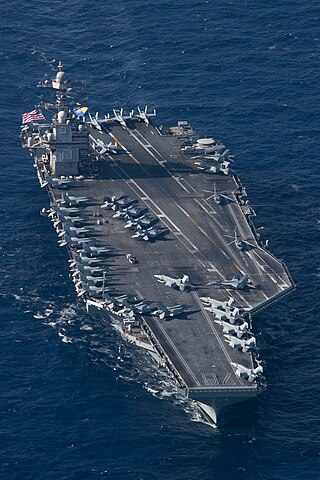
United States naval reactors are nuclear reactors used by the United States Navy aboard certain ships to generate the steam used to produce power for propulsion, electric power, catapulting airplanes in aircraft carriers, and a few more minor uses. Such naval nuclear reactors have a complete power plant associated with them. All commissioned U.S. Navy submarines and supercarriers built since 1975 are nuclear powered, with the last conventional carrier, USS Kitty Hawk, being decommissioned in May 2009. The U.S. Navy also had nine nuclear-powered cruisers with such reactors, but they have since been decommissioned as well.
The S1G reactor is a naval reactor used by the United States Navy to provide electricity generation and propulsion on warships. The S1G designation stands for:
The S1C reactor was a prototype naval reactor designed for the United States Navy to provide electricity generation and propulsion on warships. The S1C designation stands for:

The S5G reactor was a prototype naval reactor designed for the United States Navy to provide electricity generation and propulsion on submarines. The S5G designation stands for:
The S6G reactor is a naval reactor used by the United States Navy to provide electricity generation and propulsion on Los Angeles-class attack submarines. The S6G designation stands for:

A nuclear submarine is a submarine powered by a nuclear reactor, but not necessarily nuclear-armed. Nuclear submarines have considerable performance advantages over "conventional" submarines. Nuclear propulsion, being completely independent of air, frees the submarine from the need to surface frequently, as is necessary for conventional submarines. The large amount of power generated by a nuclear reactor allows nuclear submarines to operate at high speed for long periods, and the long interval between refuelings grants a range virtually unlimited, making the only limits on voyage times being imposed by such factors as the need to restock food or other consumables.
The S8G reactor is a naval reactor used by the United States Navy to provide electricity generation and propulsion on warships. The S8G designation stands for:
The S1W reactor was the first prototype naval reactor used by the United States Navy to prove that the technology could be used for electricity generation and propulsion on submarines.
Bettis Atomic Power Laboratory is a U.S. Government-owned research and development facility in the Pittsburgh suburb of West Mifflin, Pennsylvania, that works exclusively on the design and development of nuclear power for the U.S. Navy. It was one of the leaders in creating the nuclear navy.
A nuclear navy, or nuclear-powered navy, refers to the portion of a navy consisting of naval ships powered by nuclear marine propulsion. The concept was revolutionary for naval warfare when first proposed. Prior to nuclear power, submarines were powered by diesel engines and could only submerge through the use of batteries. In order for these submarines to run their diesel engines and charge their batteries they would have to surface or snorkel. The use of nuclear power allowed these submarines to become true submersibles and unlike their conventional counterparts, they became limited only by crew endurance and supplies.
Air-independent propulsion (AIP), or air-independent power, is any marine propulsion technology that allows a non-nuclear submarine to operate without access to atmospheric oxygen. AIP can augment or replace the diesel-electric propulsion system of non-nuclear vessels.

The A1B reactor is developed by the United States Navy for the Gerald R. Ford-class nuclear-powered aircraft carriers. Each ship will be powered by two A1B reactors. The new reactor was named A1B, following the Navy's reactor-designation scheme of type, generation, and manufacturer: A for aircraft carrier, 1 for the maker's first reactor plant design, and B for Bechtel, the company making the reactor.

The S9G reactor of the United States Navy is designed to generate electricity and propulsion for the Virginia-class attack submarines. The name S9G follows the designation scheme of platform type (submarines), generation, and the contractor.
The S5W reactor is a nuclear reactor used by the United States Navy to provide electricity generation and propulsion on warships. The S5W designation stands for:

Knolls Atomic Power Laboratory (KAPL) is an American research and development facility based in Niskayuna, New York and dedicated to the support of the US Naval Nuclear Propulsion Program. KAPL was instituted in 1946 under a contract between General Electric and the United States government. In the 21st century, KAPL is a government-owned, contractor-operated laboratory for the US Department of Energy. KAPL is responsible for the research, design, construction, operation, and maintenance of U.S. nuclear-powered warships. It also manages work on nuclear ships at numerous shipyards across the country.
The S2C reactor is a naval reactor used by the United States Navy to provide electricity generation and propulsion on warships. The S2C designation stands for:

The S3W reactor is a naval reactor used by the United States Navy to provide electricity generation and propulsion on warships. The S3W designation stands for:

The S4G reactor is a naval pressurized water reactor used by the United States Navy to provide electricity generation and propulsion on warships. The S4G designation stands for:

The S4W reactor was a naval reactor plant used by the United States Navy to provide electricity generation and propulsion on warships. The S4W designation stands for:








